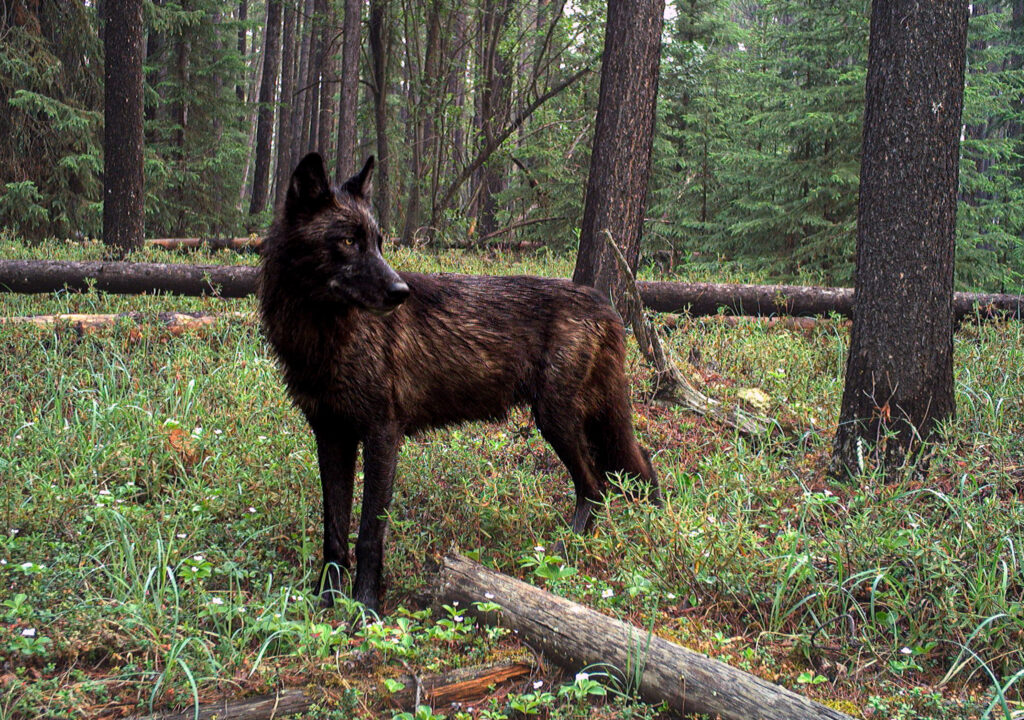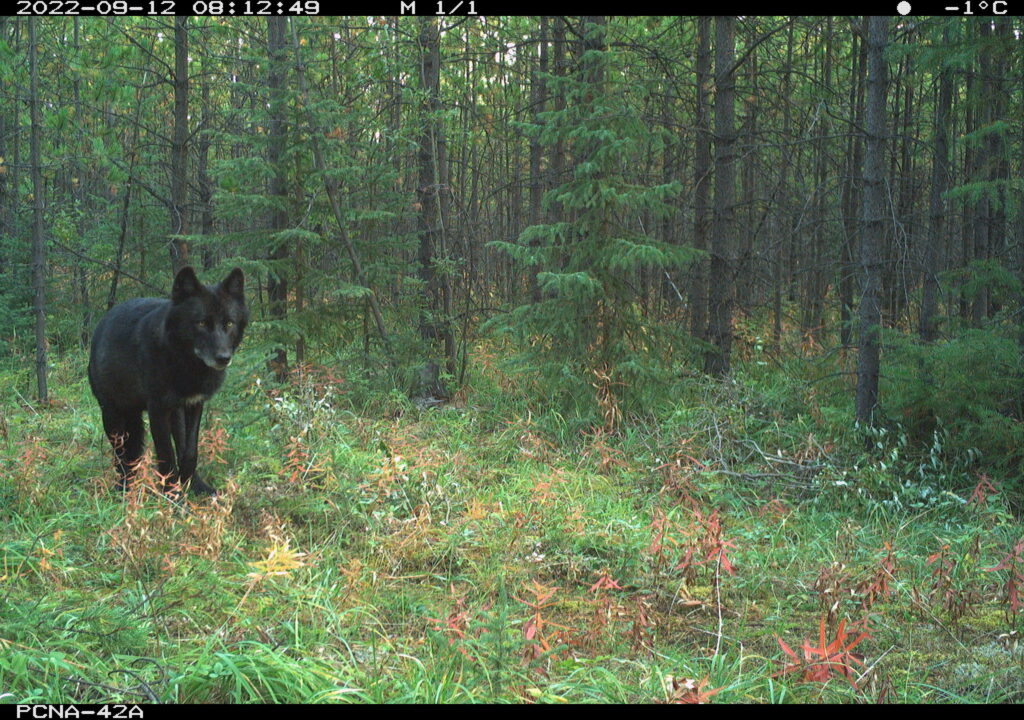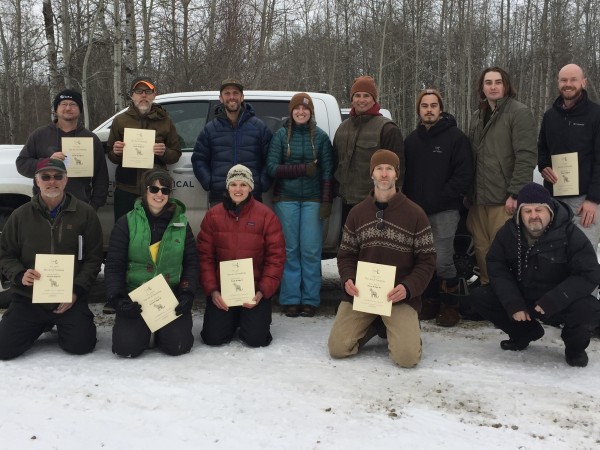The black wolf featured in this post, was captured on our remote cameras and is a striking sight against the forest’s lush greenery. Although encountering a black wolf might seem a rare event, Alberta actually has a notably high number of them. In Alberta, 55% of wolves are black, compared to just 33% in northern British Columbia and 32% in Alaska (AWA 2024). This variation between geographically similar areas is interesting, particularly when considering the origin and history of black wolves.

Black wolves have only existed for several thousand years, while the grey wolf has been around for about a million years (NLWC 2018). Despite their colour differences, black and grey wolves are the same species; the colour variation is due to a genetic mutation. It is believed that the black mutation emerged when early domestic dogs, which carried the mutated gene, interbred with wild wolves. This gene was passed on to the offspring, resulting in the black wolves we might be lucky enough to see today.

Colouration in Canis lupus, on a very simplified level, is determined by a single gene for colour inherited from each parent. If the mutated form of the gene causing black colour is inherited, the offspring will be black. Genetically, there are two types of black wolves: homozygous, and heterozygous. Homozygous wolves carry two mutated pigment genes, while heterozygous black wolves carry one dominant mutated gene and one recessive grey pigment gene (Durvasula 2018). Both heterozygous and homozygous dominant wolves appear black because the dominant black pigment gene overrides the recessive grey pigment gene. Grey wolves, on the other hand, have two recessive grey pigment genes. While the visible colouration of wolves may provide advantages or disadvantages depending on the situation, the genetic effects of these colour-coding genes are profound, endowing each genotype with distinct advantages.

Different genotypes in black wolves and grey wolves can affect their success in various ways. When comparing their behaviours, grey wolves tend to be more aggressive and dominant, while black wolves present more docile behaviour, due to lower levels of the hormone cortisol. Multiple studies have tested the Yellowstone National Park population of wolves and found that homozygous black wolves have lower fitness levels in comparison to heterozygous black and gray wolves. Coulson (2011) was able to prove that only 12 (4.3%) out of a population of 280 wolves were homozygous black, which demonstrates a heterozygote advantage and asymmetry in the fitness of homozygotes. Estimated values of survival rate and reproductive success across genotypes illustrates an advantage in gray and heterozygous black wolves, for survival and reproduction. Grey and heterozygous wolves appear to be more successful in populations than their homozygous black counterparts. Causes of different fitness levels between genotypes is still not fully understood, and requires further investigation.

Another factor that can influence the biological success of black and grey wolves is their immunity. The same mutated gene responsible for the black colouration in wolves also enhances their ability to fight certain diseases. The gene affects a protein that plays a role in the immune system. As a result, black wolves have a better ability to fight and recover from distemper, a virus that attacks the gastrointestinal, respiratory, and nervous system of canines (AVMA 2018).

The proportional population of black versus grey wolves varies across North America. Since black wolves have a higher chance of surviving distemper, it is speculated that in areas with a history of distemper outbreaks, there may be a higher proportion of black wolves. Additionally, wolves in these regions might preferentially choose black mates to produce black offspring with a resistance to distember. Research from Oxford supports this theory, Cubaynes (2022) was able to predict high black wolf proportions based on frequent historical distemper outbreaks across 12 populations, showing that areas with more distemper outbreaks have a higher proportion of black wolves.

The study also suggests that wolves in these areas are more likely to mate to produce black offspring. Conversely, in regions with fewer distemper outbreaks, wolves prefer mates that result in grey offspring. This preference helps to explain the rarity of black wolves, despite the dominance of the black gene. Behavioural differences, such as increased docility in black wolves, and their higher visibility to prey and humans hunting or culling wolves, likely contribute to this selection process. The biological advantages of each colour will continue to fluctuate depending on environmental conditions, leading to changes in the proportion of black and grey wolves in different populations.

The Black Wolf was researched, written, and illustrated by Bria Griffin
References
AVMA (American Veterinary Medical Association). 2024. “Canine Distemper”. https://www.avma.org/resources-tools/pet-owners/petcare/canine-distemper#:~:text=Canine%20distemper%20is%20a%20contagious,at%20risk%20of%20canine%20distemper.
AWA (Alberta Wilderness Association), 2024. “Wolves.” https://albertawilderness.ca/issues/wildlife/wolves/#parentHorizontalTab1.
Cassidy, Kira A., L. David Mech, Daniel R. MacNulty, Daniel R. Stahler, Douglas W. Smith. 2017. “Sexually dimorphic aggression indicates male gray wolves specialize in pack defense against conspecific groups”. https://www.wolf.org/wp-content/uploads/2013/08/358-Sexually-dimorphic-aggression-indicates-male-gray-wolves….pdf
Coulson, Tim. Daniel R. MacNulty, Douglas W. Smith, Daniel R. Stahler, Bridgett Vonholdt, Robert K. Wayne. 2011 “Modeling Effects of Environmental Change on Wolf Population Dynamics, Trait Evolution, and Life History”. Science. 334(6060). https://www.science.org/doi/abs/10.1126/science.1209441
Cubaynes, Sarah, Ellen E. Brandell, Daniel R. Stahler, Douglas W. Smith, Emily S. Almberg, Susanne Schindler, Robert K. Wayne, Andrew P. Dobson, Bridgett M. Vonholdt, Daniel R. MacNulty, Paul C. Cross, Peter J. Hudson, Tim Coulson. 2022. “Disease outbreaks select for mate choice and coat color in wolves”, https://www.science.org/doi/10.1126/science.abi8745
Durvasula, Arun, Daniel R. Stahler, Douglas W. Smith, Elaine A. Ostrander, Ettore Randi, Joel Smith, John Novembre, Kirk E. Lohmueller, Marco Galaverni, Olaf Thalmann, Rena M. Schweizer, Richard E. Green, Robert K. Wayne, Samuel H. Vohr. 2018. “Natural Selection and Origin of a Melanistic Allele in North American Gray Wolves”. Molecular Biology and Evolution. 35(5). Pages 1190-1209. https://academic.oup.com/mbe/article/35/5/1190/4913657
Hedricks, Phillip W., Daniel R. Stahler, Dick Dekker. 2014. “Heterozygote Advantage in a Finite Population: Black Color in Wolves”. Journal of Heredity. 105(4). Pages 457-465. https://academic.oup.com/jhered/article/105/4/457/2961897
NLWC (Northern Lights Wolf Centre). 2018. “About Wolves: Facts About Wolves of the Rock Mountains”. https://northernlightswildlife.com/learn-about-wolves/
Pesaturo, Janet. 2020. “Wolf Coat Colour Variation and Immune System”. https://winterberrywildlife.ouroneacrefarm.com/2020/04/23/wolf-coat-color-variation-and-the-immune-system/





